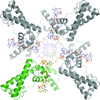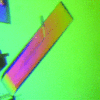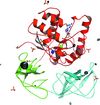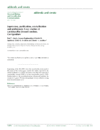issue contents
September 2013 issue

Cover illustration: EF-Tu with the brominated fragment 5-bromo-2-furancarboxylic acid bound (Grøftehauge et al., p. 1062).
structural communications
Structures of a protein–ssDNA complex suggest a possible approach for engineering crystal contacts by virtue of G-quartet formation.
PDB reference: σA2–3–TGTACAATGGG, 4ki2
The crystal structure of B. anthracis isochorismate synthase DhbC, which is involved in the biosynthesis of bacillibactin, was determined at 2.4 Å resolution. It was compared with other chorismate-utilizing enzymes and both structural and bioinformatics analyses were performed. The putative active site was pinpointed.
PDB reference: DhbC, 3os6
Open  access
access
 access
accessStructural analysis of DNA–protein complexes regulating the restriction–modification system Esp1396I
Comparison of bound and unbound DNA in protein–DNA co-crystal complexes reveals insights into controller-protein binding and DNA distortion in transcriptional regulation.
The crystal structure of NAD+-bound FDH from P. aeruginosa was determined to 2.7 Å resolution. The overall structure is very similar to that of P. putida FDH. Preliminary kinetics analysis of the enzyme indicated a glutathione-independent bi-substrate `ping-pong' catalytic mechanism.
PDB reference: NAD+-bound formaldehyde dehydrogenase, 4jlw
Major conformational changes are reported in the structure of unliganded amylosucrase from D. radiodurans.
PDB reference: amylosucrase, 4ays
The crystal structure of A. pernix L7Ae is reported, providing insight into the extreme thermostability of this protein.
PDB reference: L7Ae, 2fc3
The conserved protein MO25 activates STE20 family kinases. The crystal structure of zebrafish MO25 is reported, which is similar to that of human MO25.
PDB reference: zebrafish MO25, 4kzg
crystallization communications
The ancestral androgen receptor was crystallized in complex with 5α-dihydrotestosterone (DHT) and a fragment of the transcriptional mediator/intermediary factor 2.
The keratin-like domain of the transcription factor SEPALLATA 3 was purified and crystallized. Native data were collected to 2.53 Å resolution from a single crystal belonging to space group P21212.
Open  access
access
 access
accessThe 23S rRNA methyltransferase RlmJ from E. coli has been cloned, expressed, purified and crystallized. X-ray diffraction data to 1.85 Å resolution have been collected from the apo RlmJ crystals.
The crystallization and preliminary X-ray analysis of the full-length amylomaltase from C. glutamicum are reported.
A cold-active β-1,4-D-mannanase from the Antarctic springtail C. antarcticus (CaMan) has been expressed, purified and crystallized. The CaMan crystal belonged to space group P212121, with unit-cell parameters a = 73.40, b = 83.81, c = 163.55 Å, and diffracted to 2.35 Å resolution. A 2.40 Å resolution data set was also collected from a CaMan–mannopentaose complex crystal.
Leucyl aminopeptidase from H. pylori was purified and crystallized by the hanging-drop vapour-diffusion method. A diffraction data set was collected to 2.8 Å resolution.
A complete neutron data set was collected from a medium-sized H/D-exchanged crystal of KDN9P phosphatase. Initial refinement to 2.3 Å resolution using only neutron data showed significant density for catalytically important residues.
Human myosin 1c and its light chain calmodulin were co-expressed and purified to homogeneity from Sf9 cells and crystallized. The crystals belonged to space group P21 and diffracted to 3 Å resolution.
In this study, the variable domain of the collagen-like protein Scl2 from invasive M3-type S. pyogenes has successfully been crystallized. Single-wavelength anomalous dispersion experiments have been carried out to obtain experimental phases by preparing crystal derivatives with lanthanides. Model building and refinement, which are in progress, will provide the first structural clues for Scls.
The human TRAF4 TRAF domain was crystallized and the crystals were found to belong to space group P212121, with unit-cell parameters a = 58.9, b = 87.9, c = 117.3 Å, α = β = γ = 90°. The crystals were obtained at 293 K and diffracted to a resolution of 2.3 Å.
The central dimerization domain of the ethylene receptor ERS1 from A. thaliana was expressed, purified and crystallized. The crystals belonged to space groups C2221 and P21212.
Adenylosuccinate synthetase from C. neoformans has been crystallized and the crystals diffracted to a resolution of 2.2 Å.
Alcohol dehydrogenase (ADH) catalyzes the oxidation of alcohols using NAD(P)+ as a cofactor. The adh gene from K. koreensis was cloned and the protein was expressed, purified and crystallized. A preliminary X-ray crystallographic analysis of the ADH crystal was performed.
Alanine racemase (ALR) catalyzes the racemization of L-alanine to D-alanine with pyridoxal 5′-phosphate (PLP) as a cofactor. The alr gene from A. baumannii OXA-23 was cloned and the protein was expressed, purified and crystallized. A preliminary X-ray crystallographic analysis of the ALR crystal was performed.
Tn3 proteins, a novel class of binding molecules based on a fibronectin type III domain, have been cloned, expressed, purified and crystallized in complex with their cognate target.
The overproduction, co-purification, crystallization and preliminary X-ray analysis of the complex between importin β and Snail zinc finger domain are described.
Crystals of the V. cholerae HigBA2 complex and of the C-terminal domain of HigA2 diffracted to 2.2 and 1.8 Å resolution, respectively.
laboratory communications
X-ray crystallographic screening can provide both leads for high-affinity small-molecule development and information about potential substrate sites. In this study, in work on the well-studied protein T. thermophilus EF-Tu, brominated fragments were used for easy identification in anomalous maps.
Open  access
access
 access
accessSerial femtosecond X-ray (SFX) diffraction extending beyond 6 Å resolution using T. thermophilus 30S ribosomal subunit crystals is reported.
addenda and errata
Free 



 journal menu
journal menu






































![[publBio]](/logos/publbio.gif)






